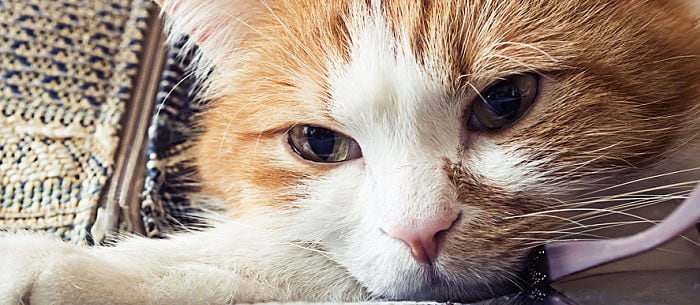A fever isn’t fun for anyone, including your cat. Complicating a cat fever is the fact that a simple forehead check doesn’t work on a cat as it does with a human. Treating a fever is different for cats, too. So how do you know if your cat has a fever and if so, what to do about it? Cuddles may help a cat who isn’t feeling well, but they won’t be enough to treat a temperature — even in the most fearless feline.
Cat Fever Symptoms and Causes
“The main symptoms of fever in cats are loss of appetite and lethargic behavior. Your cat may also hide if he feels uncomfortable,” says veterinarian Dr. Laura Brown of GreenTree Animal Hospital in Libertyville, Illinois. These aren’t the only symptoms. “A cat with a fever will be quiet and withdrawn, but may or may not feel warm to the touch.
Depending on the underlying cause, there may be sneezing, runny eyes, vomiting, diarrhea, weakness, pale gums or lameness,” adds Dr. Debra M. Givin, a vet with The Cat Doctor in Portland, Maine.
Conditions that might cause your cat to spike a fever include the following:
- Bacterial infections like Bartonella, also known as cat scratch fever
- Viruses or viral infections
- Fungal infections
- Injuries or abscesses resulting from animal fights
- Tumors
- Immune-mediated disease
Diagnosing a Cat Fever
You can diagnose a cat fever at home, but the procedure is not for the faint of heart and requires multiple hands on deck. “It’s possible to take a cooperative cat’s temperature at home, but if she struggles, it can be dangerous for both cat and owner. You’ll need a digital rectal thermometer (the faster acting, the better) and a generous amount of lubricant. One person should stroke and comfort the cat, while the other gently inserts the thermometer one-half inch to one inch into the rectum.
“If the temperature is above 102.5 degrees Fahrenheit, the cat has a fever and should see a veterinarian to determine the underlying cause,” explains Dr. Anne Richards, a veterinarian with The Cat Doctor of Bedford and Nashua. Unfortunately, there’s no easier way to get a reading. “Thermometers designed for human ears are not much easier to use and may not give accurate readings,” adds Dr. Givin. Cat noses and ears, even when hot and dry to the touch, do not indicate a fever accurately.
Taking Care of a Feverish Cat
While a cat may seem almost human at times, treating your pet’s fever the way you would your own can do tremendous harm. “Owners should never attempt to treat fever at home,” warns Dr. Richards. “Acetaminophen (Tylenol) is deadly for cats, and other non-steroidal anti-inflammatory medications, such as ibuprofen and aspirin, can cause serious, sometimes fatal side effects.”
A cat’s fever is always a symptom of an underlying cause, so treating the core issue is important. After diagnosis, your veterinarian may determine that antibiotics or anti-inflammatory medications are needed. He or she may also opt to provide fluids for your cat intravenously, to avoid dehydration and help her feel better faster.
You may not be your cat’s doctor, but you are her best friend. Even if you can’t treat her fever at home, she needs and will appreciate your tender loving care while she’s waiting to feel better.
Comforting Your Cat
“Keep your cat in a quiet place and follow the treatment plan discussed with your veterinarian,” advises Dr. Givin. “Supportive care from you or a pet sitter in the form of frequent, tasty, small meals, keeping nose and eyes clean for upper respiratory infections or hot packing for bite wounds may be needed.” She adds that, for sick cats, it’s important they “eat, drink, pee and poop” and recommends that you have everything your cat depends on close by. “A sick cat won’t want to make a long trip for the litter pan, meals or much-needed fluids,” she notes.
Keeping kitty comfy pre-appointment is important, too. Keep the water bowl close by and let your cat stay snug and comfy in a secluded, quiet place while you’re waiting.
Have patience. Your cat’s fever may take time to break, depending upon its cause, Consider this to be much-needed oasis of quiet time both of you can share together until the winds shift. Given proper care and lots of love, your baby will be happily purring up a storm in no time.
If you think your cat’s fever may be caused by the cat flu, read Cat Flu: What It Is and How to Spot It.
Corey Kagan Whelan is a freelance writer and animal lover living in New York. You can follow her on twitter.
*This article is for general informational purposes only. It is not intended nor implied to be providing medical advice and is not a substitute for such advice. The reader should always consult a health care provider concerning any medical condition or treatment plan. Neither Care.com nor the author assumes any responsibility or liability with respect to use of any information contained herein.



